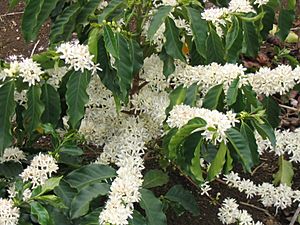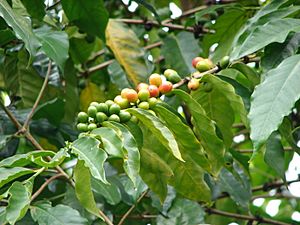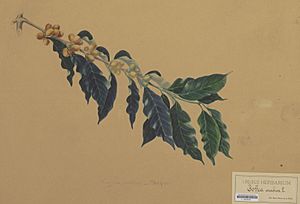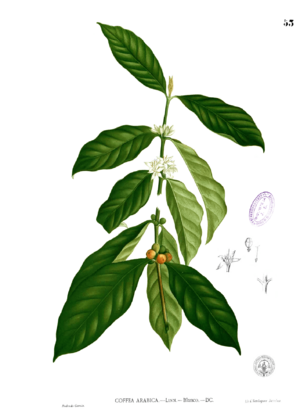Coffea arabica facts for kids
Quick facts for kids Arabic coffee |
|
|---|---|
 |
|
| Coffea arabica flowers | |
 |
|
| Coffea arabica fruit | |
| Conservation status | |
| Scientific classification | |
| Genus: |
Coffea
|
| Species: |
arabica
|
Coffea arabica (say it: uh-RAB-ih-kuh), also known as Arabic coffee, is a type of flowering plant in the coffee family. It's thought to be the very first kind of coffee grown by people. Today, it's the most popular coffee in the world, making up about 60% of all coffee produced!
Arabic coffee first came from Yemen. People started growing it there a long, long time ago. The word for coffee in Arabic is "būnn," which comes from the Amharic word "Buna."
Contents
What is Coffea arabica?
Coffea arabica was first studied by a scientist named Antoine de Jussieu. He called it Jasminum arabicum because he saw it in a garden in Amsterdam. Later, in 1737, Carl Linnaeus gave it its own group, called Coffea.
This type of coffee plant is special because it has four sets of chromosomes. Most other coffee plants only have two sets. Coffea arabica actually formed naturally from two other coffee types mixing together a very long time ago. This happened between 1 million and 500,000 years ago in East Africa.
What does the plant look like?
Wild Coffea arabica plants can grow quite tall, between 9 and 12 meters (30 to 40 feet). They have many branches. The leaves are dark green and shiny. They are about 6 to 12 cm (2 to 5 inches) long.
The flowers are white and smell very sweet, like jasmine. They are about 1 to 1.5 cm (0.4 to 0.6 inches) wide. The seeds are inside a fruit called a "cherry." These cherries are 1 to 1.5 cm wide. They start green, then turn bright red or purple when they are ripe. Each cherry usually has two seeds inside, which we call coffee beans.
Where does Arabic coffee grow?
Coffea arabica originally comes from the high lands of Ethiopia in Africa. Today, it's rare to find truly wild plants there. However, it is now grown in many countries around the world. You can find it between the Tropic of Capricorn and the Tropic of Cancer.
It grows well as a small tree under taller trees. You can also find it in South Sudan and Kenya. This coffee plant has spread and grown wild in many places. These include parts of Africa, Latin America, Southeast Asia, India, China, and islands in the Caribbean and Pacific.
The coffee tree first came to Hawaii in 1813. By 1850, many people were growing it there. In some valleys, it has even become a weed because it grows so easily. It can also be a problem in places like Sri Lanka and parts of Australia.
How did coffee become popular?
The first written records of coffee come from Arab scholars. They wrote that drinking coffee helped them stay awake and work longer. The idea of making a drink from roasted coffee beans started in Yemen. From there, it spread to Egypt and Turkey. Eventually, it traveled all around the world.
Some people believe coffee plants were brought from Yemen a very long time ago. In Indonesia, Arabic coffee production started in 1699. This happened because of trade from Yemen. Indonesian coffees, like those from Sumatra and Java, are known for being strong and not very acidic. This makes them great for mixing with coffees from Central America and East Africa.
Growing and using Arabic coffee
Coffea arabica makes up 60% of all the coffee produced worldwide.
It takes about seven years for a C. arabica plant to grow fully. It needs about 1 to 1.5 meters (40 to 60 inches) of rain each year. This rain should be spread out evenly. It usually grows at high places, between 1,300 and 1,500 meters (4,300 to 4,900 feet) above sea level. Some farms grow it even higher or lower.
The plant can handle cool temperatures, but it cannot survive frost. It grows best when the average temperature is between 15 and 24 degrees Celsius (59 and 75 degrees Fahrenheit). Farmers often trim the plants to about 2 meters (6.5 feet) tall. This makes it easier to pick the coffee cherries. Unlike other coffee types, C. arabica likes to grow in light shade.
Flowers and cherries
Two to four years after planting, C. arabica produces small, white, very sweet-smelling flowers. These flowers only last a few days. After the flowers are gone, the coffee cherries start to grow. They are dark green at first. Then they turn yellow, then light red, and finally a shiny, deep red. When they are deep red, they look like regular cherries and are ready to be picked.
The cherries are about 1 cm (0.4 inches) long. It's important to pick them at the right time. If they are picked too early or too late, the coffee won't taste as good. Because they don't all ripen at the same time, many are picked by hand.
Each coffee tree can produce from 0.5 to 5.0 kg (1 to 11 pounds) of dried beans. This depends on the tree and the weather. The most valuable part of the plant is the beans inside the cherries. Each cherry usually has two beans. These beans are covered by two thin layers, like skin.
In some places, like Java, coffee trees are planted and harvested all year. In other places, like Brazil, they have a specific season for harvesting, usually in winter. These plants can be easily harmed by cold weather or bad soil. They are also more likely to get pests than the Robusta coffee plant.
Scientists think that global warming might cause problems for wild C. arabica plants. Rising temperatures and changing rainfall patterns could make it harder to grow this coffee. This is why people are trying to grow new types of coffee plants that can handle these changes.
Some of the best and most famous Arabic coffee beans come from places like Jamaican Blue Mountain, Colombian Supremo, Tarrazú in Costa Rica, Guatemalan Antigua, and Ethiopian Sidamo.
Special types of Arabic coffee
There is a special type of Coffea arabica that naturally has very little caffeine. Regular C. arabica beans have about 12 milligrams of caffeine per gram. But these special ones have only about 0.76 milligrams per gram. They still taste very similar to normal coffee!
Why is Arabic coffee in danger?
Even though there are billions of wild C. arabica plants, it is still considered an endangered plant. This is because of several threats.
One big threat is deforestation. This means forests are being cut down. C. arabica needs forests to grow because it likes to grow under taller trees. Ethiopia used to have a lot more forest, but now much of it is gone.
Climate change is also a major problem. C. arabica is very sensitive to high temperatures. Scientists think that the number of wild plants could drop by 50% to 80% by the year 2088. Climate change can also affect how well the plants reproduce. A pest called the coffee berry borer might also spread to higher places because of warmer temperatures. This could harm coffee plants even more.
To protect the different types of C. arabica, we need to save the wild coffee plants in the rainforests of Yemen. Most of the coffee grown on farms today came from just a few wild plants from Yemen. This means that the coffee on farms has much less variety than the wild coffee.
Climate change also threatens the coffee grown on farms. Some studies guess that by 2050, more than half of the land used for growing coffee might not be good for it anymore. Because of this, a more heat-tolerant coffee species, Coffea stenophylla, might become the main type of coffee grown in the future.
Images for kids
-
Unroasted ("green") coffee (Coffea arabica) seeds from Brazil.
See also
 In Spanish: Cafeto arábigo para niños
In Spanish: Cafeto arábigo para niños















